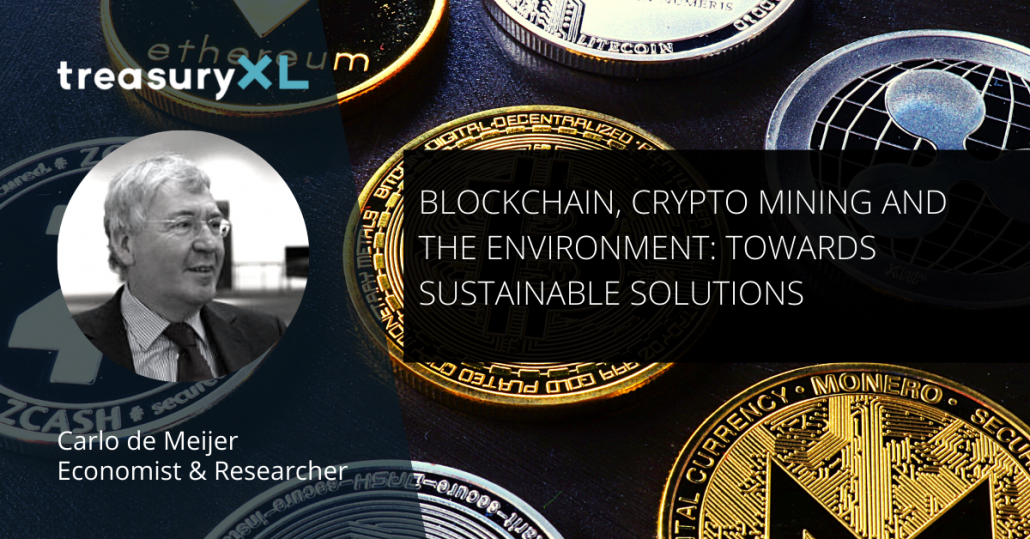Blockchain, crypto mining and the environment: towards sustainable solutions
21-02-2022 | Carlo de Meijer | treasuryXL | LinkedIn |
Blockchain has always been presented as providing speed, efficiency and low costs. But there is also a flipside. Since the crypto industry is booming, including DeFi and NFT, and blockchain technology is going more mainstream the discussion of their negative impact on the environment is heightening.

Blockchain consumes huge amounts of energy and that is growing by the day. This while the combat of the climate crisis has the highest priority all over the world. Especially the electricity usage of Bitcoin and other similar blockchain networks have pulled into a larger conversation around sustainability. To understand this we should go back to the basics of how blockchain works. But above all, are there ways to reduce that and could blockchain also contribute to a positive climate change?
Cleaning-up crypto mining
A recent hearing by the US Committee on Energy and Commercial Staff on “Cleaning up the Cryptocurrency: the Energy Impacts of Blockchain “ shows a very dark picture. Many blockchains, amongst which the two largest platforms Bitcoin and Ethereum, still use a so-called Proof-of-Work (PoW) mechanism to support their resp. crypto currencies that require enormous amounts of energy to operate. According to a recent analysis, the energy required for a Bitcoin transaction could power a household for more than 70 days.
How does mining work?
On the Bitcoin blockchain platform, the infrastructure is distributed and delegated to so-called ‘miners’ around the network. Each time a transaction is made, consensus must be established all across the distributed database (or at least 51% for Bitcoin, for security reasons). This is done through Proof-of-Work (PoW).
Miners are thereby responsible for processing transactions and adding them to the blockchain. These are super-users who compete for the processing work by attempting to solve highly complex algorithmic problems. Mining for PoW cryptocurrencies requires specialised computers that make trillions of guesses per second. In return for this processing, the winner is awarded new cryptocurrencies i.e. Bitcoin or Ether. This all comes down to the most powerful computer processor exerting the greatest amount of effort. After that other computers on the network quickly verify and a new block containing additional new info is then added to the blockchain. After that the mining process starts over again. A highly energy-intensive process.
As a crypto-miner increases their likelihood of identifying the correct answer by increasing the number of guesses, this process further increases computational power and is creating more energy consumption. Today, PoW miners need a great number of so-called application-specific integrated circuits (ASICS) to have any chance of reliable earnings cryptocurrency rewards on the major cryptocurrency networks. The profitability of mining as well as the increase of the value of PoW currencies requires ever-increasing amounts of energy to power and cool machines.
Environmental impact
While there are many hundreds of different cryptocurrencies, Bitcoin and Ethereum are not only the largest ones but are also the most energy-intensive. In the past few years, their environmental impact has increased greatly in terms of both energy consumption and carbon or CO2 emission.
Energy consumption
The scale of mining has increased substantially triggered by the increased value of mining. This has resulted in a rapidly increasing energy consumption. According to the Bitcoin/Ethereum Energy Consumption Index that is looking at the environmental impact of a blockchain transaction, Bitcoin is the leading coin with the most energy-intensive mining process.
A single Bitcoin transaction uses as much energy as one US household would over 73.82 days (2.5 months). The annual energy usage of the Bitcoin network last year grew from 78 Tera (trillion) watt-hours (TWH) to almost 198 TWH.
Ethereum, while less energy demanding, still uses This is as much electricity for a single transaction as a US household over 8.32 days. The annual energy usage of the Ethereum network grew from almost 15 TWH to more than 92 TWH.
CO2 emission
Bitcoin is also the most polluting cryptocurrency. In total figures and based on 2021 estimations Bitcoin mining edited more than 56.8 million tons of CO2 (or more than 1.000 pounds of CO2 per transaction) to the atmosphere. This would require more than 284 million trees in order to offset the transactions and become carbon neutral. Its total annual energy footprint is similar to Thailand while Bitcoin emits as much CO2 as Kuwait.
ETH mining emitted more than 22 million tons ( or more than 90 pounds per transaction) of CO2. Over the year, that is still as much power as the Netherlands. And as it is projected to emit almost 22 million tons of CO2 by the end of 2021, it would take planting nearly 110 million trees to offset Ehtereum’s contribution to carbon emission.
But taken together, both these blockchains use major economic amounts of energy. These are just ahead of Saudi Arabia and Italy and just behind the United Kingdom. It would be the 12th most consumptive economy on the planet.
To put these figures in perspective global 2021 CO2 emission of Bitcoin and Ethereum mining is equivalent to the emission from more than 15.5 million gasoline-powered cars on the road every year.
Bitcoin mining ban
Triggered by the chance of having too little energy left for both consumers and the broader industry, a growing number of countries is now banning or is planning to ban crypto mining.
In China, where 70% of miners worldwide were based, authorities last year has forbidden mining. Whereas since a majority of crypto mining has been moved into lower energy price countries, the present high energy prices caused by the Russian – Ukrainian crisis forced countries like Kosovo and Kazakhstan, but also Iran and India to ban crypto mining. Early this year Russia announced such a ban to prevent winter blockheads. Even in the EU an ESMA official suggested also banning crypto mining. And it is expected that other countries will follow.
Ethereum: shift from Proof-of-Work (PoW) to Proof-of-Stake (PoS)
There however are also positive developments within the blockchain world towards climate change. Blockchain technology is still young but is advancing and slowly, but definitely, crypto mining is increasingly driven by more renewable energy. And in the meantime, there is a number of other ground-breaking energy-saving solutions.
Proof-of-State networks
A promising one is the change-over from Proof-of-Work (PoW) to Proof-of-Stake (PoS) networks, that do not require miners to compete for energy power for zero-sum awards. This could greatly limit energy consumption and carbon emission, thereby mitigating the negative impact of blockchain on the environment.
Proof-of-stake blockchains are newer generation networks. Instead of miners, PoS use a network of ‘validators’ who will stake their own cryptocurrency in exchange for the ability to validate a transaction in exchange for a reward. Effectively, the resource of energy is replaced by capital.
Ethereum 2
Ethereum is now moving forward with their transition from Ethereum 1 (Proof-of-Work), to Ethereum 2 (Proof-of-Stake). With this shift Ethereum hopes that it will make its blockchain both safer to use while greatly minimising energy consumption. Other major PoS networks now include names like Polkadot, Cardano, and Tezos among others.
According to UCL (University College London) research, while using far less energy than proof-of-work (PoW) network Bitcoin (relative to the number of transactions the network can perform at any one time), all the proof-of-stake networks use far less energy – two to three orders of magnitude less than Bitcoin. The same research says PoS-based systems can contribute to the challenges posed by climate change and could even undercut the energy needs of traditional central payment systems, raising hopes that blockchain technology can contribute positively to combatting climate change.
Blockchain and environmental projects: green smart contracts
But there is another – and even more positive – side of blockchain-related to the environment and climate change. Blockchain technology could also be linked to various environmental projects by using so-called green smart contracts.
Green smart contracts
Green smart contracts running on blockchain may unlock new ways to fight climate change and to cope with its impact. At its core, the fight against climate change is going to require a massive shift in global consumption habits. Green smart contracts are an interesting tool for incentivizing participation in global green initiatives. Especially in the areas that ask for large amounts of data collection and verification and rewarding sustainable environmental behaviours, such as regenerative agriculture, carbon offsets, crop insurance etc. Green smart contracts could deliver great promises for environmental issues as these could scale up environmentally conscious blockchain-based solutions. Blockchain could thereby play a great role in stopping or reversing climate change if adopted on a global scale.
Ethereum: DApps and Oracles
The Ethereum platform facilitates the creation of decentralised apps that run on the blockchain. Some of these applications include the management of supply chains, recycling programs, energy systems, environmental treaties, environmental charities, and carbon taxes. These all may help make it more possible to address various environmental issues including air pollution, ocean sustainability, and bio diversity conservation.
This approach relies on networks of so-called oracles, entities that can share data about the world. The development of green smart contracts got a boost as oracles have become production-ready. Today these oracles are broadcasting agricultural data sets onto blockchains, enabling smart contract developers to build applications around crop yields, soil quality, weather reports, carbon offsets etc.
As more and more data sets are fed into blockchains, developers are beginning to produce a wide range of environmentally-conscious smart contracts applications, helping fight against climate change, reduce carbon footprints, sustainable conscious consumption, improve consumption habits etc.
New generation consumers and crypto: towards a more climate-conscious approach
New developments like the firm rise in cryptocurrencies, the spectacular growth of DeFi and the growing market for NFTs have attracted many from the New Generations, especially Millennials and Gen Z. This group is increasingly looking for and experiment with these more attractive digital and crypto-assets. But while many of them also worry about climate change and the consequences, most are not aware of the environmental impact of the crypto world. More delving into the world of blockchain and crypto would not be a bad idea as that could lead to a more climate-conscious approach.
Carlo de Meijer
Economist and researcher












